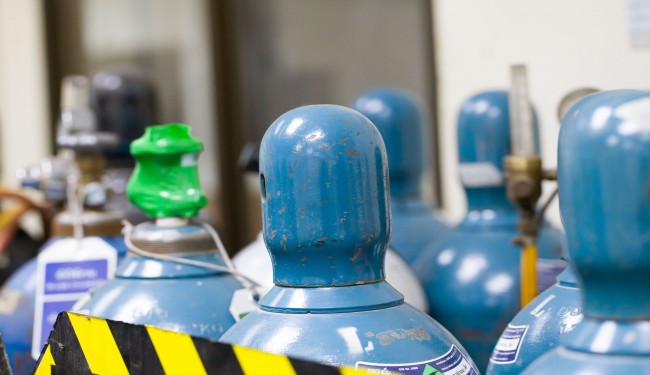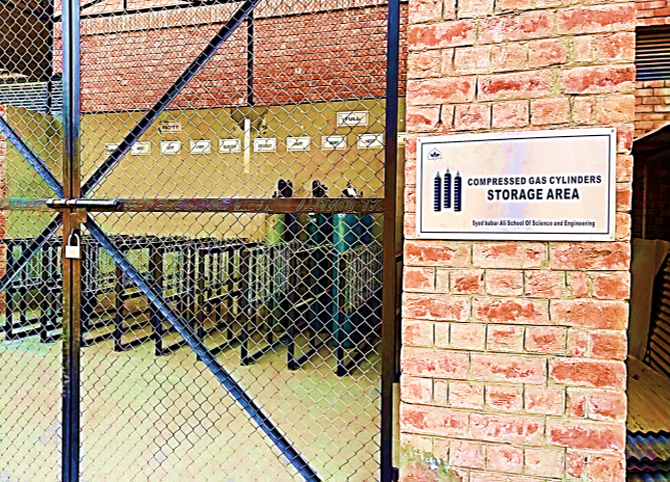Compressed Gas Cylinders

Compressed gas cylinders contain varying pressures of inert, toxic, flammable, oxidizing, corrosive, or combinations of gases. Care in using, handling, and storing compressed gas cylinders is required due to the high potential for severe incident.
General Safety
- Cylinders must be transported, stored, and used upright (with the valve up), and must be securely fastened to prevent them from falling or being knocked over. Suitable racks, straps, chains, or stands are required to support cylinders.
- Cylinder valves are to be protected with the standard cap when not in use (empty or full). Regulators are to be protected with covers where there is a likelihood of damage.
- Never force a cap or regulator. The cap should only be hand tight.
- Cylinders should not be exposed to excessive dampness or corrosive chemicals or fumes.
- Cylinders are not to be exposed to temperature extremes nor stored in the vicinity of combustibles.
- Gases are not to be transferred from one vessel to another (except dry ice and cryogenic material). Do not try to refill compressed gas cylinders.
- Before using a cylinder, slowly "crack" the valve to clear dust or dirt, being sure the opening is not pointed toward anyone. Do not stand in front of the regulator gauge glass when opening the valve.
- Never use a cylinder without a regulator. Always use the correct pressure regulator.
- After attaching the regulator and before the cylinder is opened, check the adjusting screw of the regulator to see that it is released. Never permit the gas to enter the regulator suddenly.
- Never try to stop a leak between a cylinder and regulator by tightening the union nut unless the valve has been closed first.
- Never use a leaking, corroded, or damaged cylinder. Remove the cylinder from the service and contact the supplier for return.
Cylinders Storage
- Compressed gas cylinders shall be stored outside the SSE building in a designated storage room and their record must be maintained at each respective department.
- The storage area shall contain the appropriate safety signage.
- The storage area shall be secured, and only authorized persons will have access to compressed gas storage areas.
- Cylinder storage areas must be prominently posted with the names and hazard class of the gases to be stored.
- Cylinders not “in use” (“in use” means connected through a regulator to deliver gas to a laboratory operation, connected to a manifold used to deliver gas to a laboratory operation or a single cylinder secured alongside the cylinder as the reserve cylinder) must not be stored in the laboratory.
- When gases of different types are to be stored at the same location, cylinders should be grouped by type of gas and the groups arranged to take into account the type of gas contained (e.g., flammable gases may not be stored next to oxidizing gases).
- Empty cylinders should be stored separately from filled cylinders.
- Storage rooms should be dry, cool, and well ventilated. Cylinders should not be stored at temperatures above 51 degrees °C. (125 degrees F.) or near radiators or other sources of heat.
- Cylinders must be stored a minimum of 20 feet from incompatible materials and a minimum of 10 feet from combustible materials.
- Cylinders stored outside must be protected against extremes of weather, and combustible waste must be kept a minimum off 10 feet from the cylinders.
- Cylinders must be protected from any object that will produce a cut or other abrasion on the surface of the metal.
- Do not place cylinder near elevators or gangways, or in locations where heavy moving objects may strike or fall on them.
- All gas cylinders must be capped and secured when stored. Cylinders must be stored in the upright position unless designed for use in the horizontal position. Each cylinder must be individually secured.


